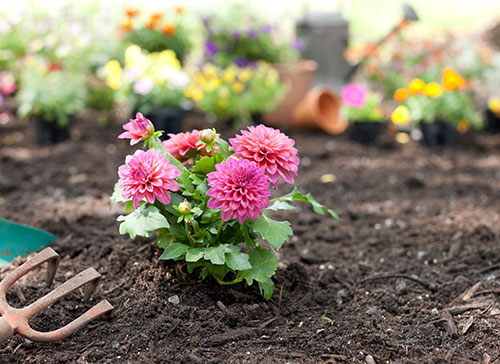Colorful Blooms All Year Round
March 1, 2024Designing a Family-Friendly Yard: Safe and Fun Spaces for Everyone
May 1, 2024Eco-friendly Landscaping: Sustainable Practices for a Greener Future
In an era of increasing environmental awareness, homeowners are seeking ways to minimize their ecological footprint and create landscapes that are not only beautiful but also sustainable. Eco-friendly landscaping practices offer a solution by promoting biodiversity, conserving resources, and reducing environmental impact. From water-wise gardening to native plantings and organic maintenance techniques, there are numerous strategies available to transform your outdoor space into a haven for both people and nature. In this guide to eco-friendly landscaping, we’ll explore sustainable practices and actionable tips for creating a greener future right in your own backyard.
Native Plants: Enhancing Biodiversity
Native plants are species that naturally occur in a particular region and have evolved to thrive in local environmental conditions. By incorporating native plants into your landscape, you can create habitat for native wildlife, support pollinators such as bees and butterflies, and promote biodiversity. Native plants require less water, fertilizer, and pesticides than non-native species, making them an eco-friendly choice for landscaping. Additionally, native plants are often more resilient to local climate extremes and soil conditions, reducing the need for intensive maintenance.
Fact: According to the National Wildlife Federation, native plants support a wide range of wildlife species, including birds, mammals, insects, and amphibians. For example, native milkweed plants are essential for the survival of monarch butterflies, whose populations have declined due to habitat loss and pesticide use.
Action Step: Research native plant species that are well-suited to your region’s climate, soil type, and sun exposure. Visit local nurseries or native plant sales to find a variety of native plants to incorporate into your landscape. Consider creating a “pollinator garden” with a diverse mix of native flowering plants to attract bees, butterflies, and other beneficial insects.
Water-Wise Gardening: Conserving Water Resources
Water scarcity is a growing concern in many regions, making water conservation a top priority for eco-conscious homeowners. Water-wise gardening techniques help reduce water usage in the landscape while maintaining healthy and vibrant plantings. Key strategies for water-wise gardening include:
- Drought-Tolerant Plants: Choose plant species that are well-adapted to local climate conditions and require minimal irrigation once established. Drought-tolerant plants typically have deep root systems and succulent leaves that help them withstand periods of dry weather.
- Mulching: Apply a layer of organic mulch, such as wood chips, straw, or shredded leaves, around plants to retain soil moisture, suppress weed growth, and regulate soil temperature. Mulching also helps improve soil structure and fertility over time.
- Efficient Irrigation: Install drip irrigation systems or soaker hoses to deliver water directly to the root zone of plants, minimizing evaporation and runoff. Use timers and moisture sensors to optimize irrigation schedules and avoid overwatering.
Fact: According to the Environmental Protection Agency (EPA), outdoor water use accounts for nearly 30% of total household water use in the United States. By implementing water-wise gardening practices, homeowners can significantly reduce their water consumption and contribute to water conservation efforts.
Action Step: Conduct a water audit of your landscape to identify areas where water conservation measures can be implemented. Replace water-thirsty turfgrass with drought-tolerant groundcovers, ornamental grasses, and native plantings. Install a rain barrel or cistern to collect rainwater for irrigation during dry periods.
Organic Maintenance: Nurturing Soil Health
Conventional landscaping practices often rely on synthetic fertilizers, pesticides, and herbicides to maintain plant health and appearance. However, these chemical inputs often have detrimental effects on soil health, water quality, and ecosystem biodiversity. Organic maintenance techniques focus on nurturing soil health and fostering natural ecological processes to support plant growth and resilience, without damaging the life around it. Key principles of organic maintenance include:
- Compost: Amend soil with compost, a rich and nutrient-dense organic material produced from decomposed plant matter. Compost improves soil structure, fertility, and moisture retention, while also providing essential nutrients for plant growth. Incorporate compost into planting beds, container gardens, and lawn areas to promote healthy root development and vigorous plant growth.
- Natural Pest Control: Implement integrated pest management (IPM) strategies to manage pest populations without resorting to chemical pesticides. Encourage natural predators such as ladybugs, lacewings, and predatory insects to control pest insects. Use physical barriers, companion planting, and biological controls such as beneficial nematodes to minimize pest damage and maintain ecological balance.
- Lawn Care: Practice organic lawn care techniques, such as mowing high, leaving grass clippings on the lawn, and overseeding with drought-tolerant grass species. These practices help build soil organic matter, reduce water consumption, and promote a healthy and resilient turfgrass ecosystem.
Fact: According to research published in the journal Frontiers in Environmental Science, organic farming practices can improve soil health, increase biodiversity, and reduce greenhouse gas emissions compared to conventional agriculture. Similarly, organic landscaping practices offer numerous environmental benefits, including improved soil structure, water infiltration, and carbon sequestration.
Action Step: Start a backyard composting system to recycle organic kitchen waste, yard debris, and garden trimmings into nutrient-rich compost for your landscape. Use compost as a top dressing for planting beds, a soil amendment for container gardens, or a natural fertilizer for lawn areas. Experiment with homemade compost teas and organic soil amendments to boost soil fertility and microbial activity in your landscape.
A Greener Future Starts in Your Backyard
Eco-friendly landscaping offers a pathway to creating beautiful, functional, and sustainable outdoor spaces that benefit both people and the planet. By incorporating native plants, practicing water-wise gardening, and embracing organic maintenance techniques, homeowners can reduce their environmental impact, conserve natural resources, and promote biodiversity in their landscapes. Whether you’re starting from scratch or revitalizing an existing landscape, there are endless opportunities to incorporate eco-friendly principles into your outdoor design and maintenance practices. Together, we can cultivate a greener future, one backyard at a time.


